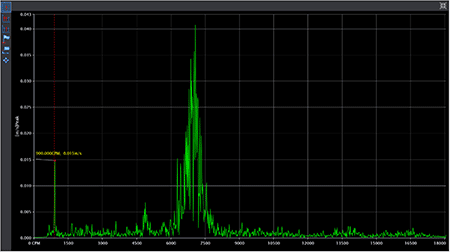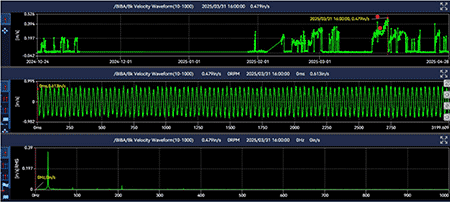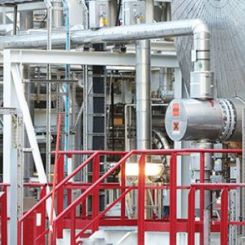
Many industrial facilities are shifting toward more proactive maintenance and reliability strategies by adopting technologies that offer novel machinery insight. Condition monitoring via scalable wireless sensors in particular has been an important component of this modern era of asset health evaluation and management. Combining wireless hardware with cloud-based analytical software allows end users to collect and trend much more information, facilitates better collaboration internally and with external experts and improves the visibility of emerging problems. Many challenges related to route-based or wired condition monitoring strategies are overcome with wireless condition monitoring systems.
Environments that are hazardous or have limited accessibility—causing safety concerns for individuals performing vibration routes—are eliminated by automated data capture. The high cost of wired systems that may have been a barrier to entry is countered by the affordability of wireless systems, which continue to reduce in price as technology advances and competition within this sector increases.
This article presents two cases where an advanced condition monitoring system was able to alert users to a potential problem and provide actionable insights to aid in diagnosis and remediation.
Case 1: Cold-Weather Vibration Patterns Reveal Hidden Machine Dynamics
The equipment at the center of the first case is a vertically mounted pump-motor system at an industrial facility in a cold climate region. The subject system had not been exhibiting overt performance issues but was enrolled in a continuous monitoring program to track baseline behavior and detect potential failure trends over time. Information collected included velocity and spectrum data from motor, pump and recirculation line sensors at regular intervals over multiple seasons.

Although vibration amplitudes remained below alarm thresholds, a consistent seasonal increase was detected in motor vibration amplitudes—up to 150%-200% higher from November through April. These trends were subtle, repeatable and pointed to environmental factors. Frequency analysis revealed a discrete peak at 900 cycles per minute (CPM) and intermittent excitation in the 3,600-7,750 CPM range. These were linked to transient cavitation events and turbulence in the system, particularly on the pump and recirculation line.
Rather than trigger alarms or unnecessary shutdowns, the condition monitoring platform enabled a deeper analysis of the machine’s behavior under environmental stress. Cavitation and turbulence issues were flagged as intermittent and seasonal, not constant. Further inspection was recommended to rule out sensor mounting issues, and the maintenance team planned a coupling inspection at the next outage.

By having continuous monitoring data available, the end user was able to not only identify an intermittent issue that may have been missed using route-based methods but also to quickly perform an in-depth risk assessment that circumvented an unnecessary shutdown.
Case 2: Thrust End Bearing Failure Identified
At a large U.S.-based chemical plant, wireless monitoring was deployed across hundreds of machines, including centrifugal blowers in their polyvinyl chloride (PVC) division. The units are critical to production, and they do not have spare backup units.

Analysis of the blower’s vibration data revealed significant anomalies. In Image 3, the trend (top graph) indicated a gradual and then sudden increase in vibration levels beginning around March 2025, peaking at 0.479 inches per second (in/s)—well above typical operational baselines. The waveform (middle graph) showed a consistent, repeating oscillation pattern, indicating mechanical looseness or surface degradation rather than random impacts. The spectrum (bottom graph) confirmed this diagnosis, with a strong peak at or near 1X running speed, characteristic of rotating element wear without significant harmonics or sidebands.
Upon inspection, physical evidence confirmed the diagnosis: Heavy wear and spalling were visible on the inboard bearing’s raceway (Image 4). The damage likely resulted from prolonged metal-on-metal contact due to lubrication degradation or normal fatigue wear.

Because the wireless condition monitoring system continuously trended and analyzed the blower’s vibration data, the maintenance team was alerted before a catastrophic bearing failure occurred. Instead of reacting to an unexpected shutdown—which could have caused extended downtime, secondary damage to the blower shaft or housing and lost production—the team was able to plan and execute a controlled replacement during a scheduled maintenance window.
By leveraging real-time monitoring and automated alerts, the plant avoided:
- An estimated 48-plus hours of unplanned downtime
- Over $100,000 in potential lost production and emergency repair costs
- Secondary damage to the blower, saving further capital expenses
As a steady stream of new companies and products enter the market, it can be overwhelming for prospective adopters to determine what solution best fits their individual needs. Taking a step back and looking at examples where this technology has been successfully applied can help refine program goals and clarify key features that support achieving these objectives.
These two cases highlight the critical role that scalable wireless condition monitoring has in adopting predictive and proactive maintenance strategies. By combining continuous data capture with advanced analytical tools, end users are able to quickly identify fault events, develop a preliminary diagnosis and advance a plan of action to validate and remediate the suspected causal factors.

